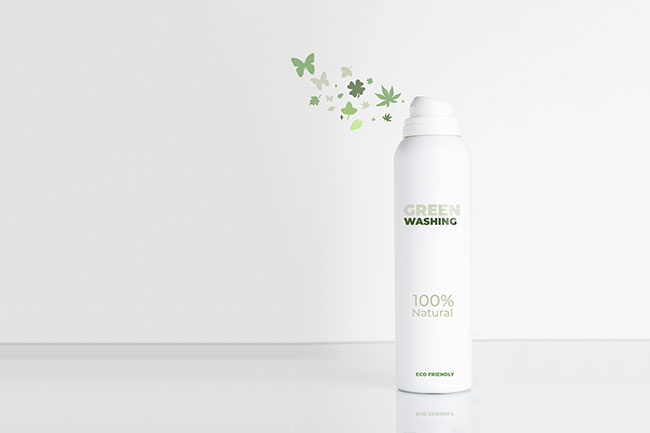
Articles
Dealer’s Corner
Beware of greenwashing
False statements about performance are actually illegal.
May 1, 2025 By Treena Hein
 The world of advertising may feel like the Wild West but there are rules.
Photo: cristianstorto/adobe stock
The world of advertising may feel like the Wild West but there are rules.
Photo: cristianstorto/adobe stock While today’s regulations make it pretty hard to overstate environmental claims, companies need to be careful in light of Competition Act updates. Today’s consumers tend to seek products and services that are more environmentally friendly – or appear to be, anyway.
Fenestration manufacturers are all under pressure to promote their products or services as “greener”: more insulating and made without materials or processes that contribute to climate change or toxins in the environment. But as stated recently by the Osler law firm, “When these environmental claims are misleading or unsubstantiated, businesses are considered to be engaging in ‘greenwashing’ and expose themselves to liability under the deceptive marketing provisions of the Competition Act.”
According to Anton Van Dyk, fenestration division manager at JRS Engineering in Vancouver, Canada’s fenestration industry has come a long way from where it was when it comes to using exaggeration in marketing. “Those who’ve been around a while will recall that up to about 20 years ago, misleading claims were somewhat common,” he explains. “Firms would often list a value for thermal efficiency of a window but, in the small print, this was identified as being the centre-of-glass value. You can’t get away with that anymore. Back in the 1980s, the U.S. government said to the industry that if you don’t regulate yourself, we will do it for you. So the U.S. industry created the North American Fenestration Council and the Canadian industry later adopted it. It created various values and standards and labelling requirements and now codes address the whole window.” The emergence of rock-solid certification bodies like UL and CSA has helped. Van Dyk also points to the emergence of more fleshed-out sustainability standards like Net Zero and PassiveHouse, which provide a framework for what can be considered environmentally friendly.
However, Terry Adamson, technical director at Fenestration Canada, notes that there are some shenanigans still afoot, such as some claims being made by fenestration suppliers that new windows will “cut 30 percent” off heating costs. “I have seen several of these with varying numbers, and none can be substantiated,” he notes. “Energy savings have far too many variables to assign a savings value to any product upgrade. This practice is still going on. I often see it in online ads for renovation windows.”
As to concerns about claims related to imported windows, Adamson says it depends who you talk to, but notes that the bulk of imported windows are higher-end, with data to back up claims. For its part, the Competition Bureau handles marketing related to both imported and domestic products. Indeed, each year the Bureau receives thousands of complaints from Canadians about all kinds of products, including greenwashing complaints (however, staff cannot share whether any of them are related to windows or doors).
“Our role is to investigate misleading advertising and deceptive marketing practices, including any representation related to the environment that has been made for the purpose of promoting a product, including an imported product or business interest,” states a Bureau spokesperson. “The Competition Act also prohibits performance claims that are not based on adequate and proper testing. This includes any form of statement, warranty or guarantee of a product’s performance, efficacy or length of life.”
Read that again slower: “…prohibits performance claims not based on adequate and proper testing.” That means that performance claims that don’t have a certification attached to them could be found to be in violation of the Act…even if they turn out to be true when challenged.
In fact, in mid-2024, the Competition Act was given sharper teeth with regard to unsubstantiated environment-related product and service claims, with a new requirement to base them “on adequate and proper substantiation in accordance with an internationally recognized methodology.” There were two rounds of public consultation about the changes and their implementation, with the second having ended in February 2025.
Osler describes the changes as “broad in scope and materially increasing the potential exposure of businesses in Canada to enforcement activity, as well as financial penalties, litigation and monetary claims from private parties. Businesses operating in Canada are advised to consider their market strategies and conduct carefully in light of the amendments and to assess whether adjustments are needed to reflect the new grounds for enforcement, legal standards and potential exposure.”
Environment-related claims can now be challenged under two new provisions, where businesses now bear the onus of proving their own statements, warranties or guarantees. And these provisions also do not require the applicant to establish that the representation is materially false or misleading in any respect.
Unintentional greenwashing
Van Dyk says he doesn’t see the intentional greenwashing situation in Canada’s window and door sector as significant. He does, however, see issues with the Energy Rating value used by Natural Resources Canada’s Energy Star program and in the National Building Code.
“It has no units, and the way it’s calculated – combining solar heat gain, U Value and air leakage – is very confusing to homeowners,” he explains. “It may lead them to buy the wrong product and I consider it unintentional greenwashing. The main problem is that a value of 30 or higher signifies a high-efficiency window but that window could have high solar heat gain. That can really heat up a house in some areas of Canada like southern B.C. in the summer.”
Interestingly, Van Dyk notes that, in B.C., the problem has been somewhat recognized. In short, the ER value was not used as a criteria in the recent Clean BC rebate program. “There were people at BC Hydro who understood the situation: that with ER used in the program, lots of windows would be installed that would cause more air conditioner use in the summers. So they advised against using ER,” Van Dyk explains. “The Clean BC program leaders listened.” He adds that there is also awareness of the issue on a national scale. “It looks like the plan is to put a cap on solar heat gain in the calculation,” Van Dyk reports. “But then ER values will come down and become meaningless. The formula won’t work anymore and so I can’t see the ER value lasting.”
But there’s more. Van Dyk also sees a similar greenwashing issue in labelling a house as an Energy Star home. “If you bought that house,” he notes, “you’d assume all of it was energy efficient: the windows, appliances, the insulation, etcetera. But it might overheat in summer. So we have to avoid lumping everything together because it creates the perception that everything is looked after, and you don’t have to look deeper into what you’re getting. It results in people having to find out later why their homes aren’t comfortable, when they could have avoided the problem had they known about it. In B.C., we have the Energy Step Code, which is more useful.”
Lastly, Van Dyk and others take issue with using “high-performance” as a general energy efficiency claim. “Yes, a window may be high-performance, but it’s a spectrum,” he says. “There are windows higher in performance than that window, and others that are lower. There’s truth in it but it’s not the whole picture. So we need to provide context with that term and other terms. In our business we’ve used the term ‘all-season,’ but it has meaning and we provide all the data. It’s a window that isn’t great for summer or winter, let’s say, but its benefits are balanced for the whole year. It makes sense for the Vancouver area, where winters are not too cold and summers not too hot.”

Clients who are sad about performance make complaints.
Photo: Prostock-studio/adobe stock
The embodied carbon landmine
Vitro Architectural Glass is an example of a glass provider that takes pride in vetting its claims. In 2017, it published third-party-verified Environmental Product Declarations (EPDs) listing the contribution to global warming (GWP) each of its products represents.
When asked whether EPDs should be legally required as a window and door product claim, Vitro’s technical services manager, Michael Hammond, isn’t definitive. He does see value in EPDs that are third-party certified and verified to be based on the North American product category rules in helping people understand the environmental impacts of their purchases and believes they should be used to help companies make better environmental choices. Furthermore, in Hammond’s view, flat glass EPDs should be used for all glass products since the majority of the GWP for an IGU comes from the flat glass itself. “This approach prevents hundreds of window makers from incurring significant costs to generate EPDs for each of their products,” he says, “costs which would ultimately be passed on to consumers.” He adds that the potential error in an EPD can be significant. “For example, if the error margin is plus or minus 20 percent, it could be as large as all the other processing steps combined in making an IGU, given that 75 to 80 percent of the GWP comes from flat glass manufacturing.” Errors this large could endanger a fenestration supplier who relies on unverified EPDs to make public claims about their product.
Durability a key claim
Many members of the global window industry believe lifespan is an important measure of environmental friendliness and should serve as a useful and important “green” claim. Rate of replacement obviously strongly impacts the raw materials and energy which go into windows, doors and buildings over their lifespan.
Hammond is of this view. He explains that even if a product claims a lower GWP or lower environmental impact but needs to be replaced twice as often over a building’s lifespan, “the true environmental impact is much greater for the product that requires more-frequent replacement. I believe the life expectancy of the North American PCR for glass is 30 years. If all glass manufacturers are basing their third-party verified EPD on the North American PCR, then one could reasonably expect a 30-year life expectancy of the glass under normal use.” Better make sure your windows actually last 30 years before claiming that they do.
In the end he concludes that, “When companies make claims without rigorous verification, it undermines the trust and transparency that are essential in our industry. False or unverified claims also have the potential to create an uneven playing field, where companies like ours that invest in sustainable practices and accurate reporting may face unfair competition and the consumer stands to lose the most by paying for a product that is not accurately represented.”
Overall, he’d like everyone to play on a level field. “If companies are taking advantage of or cheating the system, they should be held accountable,” he says. “Everyone should adhere to the same rules.”
No doubt the framers of the Competition Act had exactly the same opinion.
Print this page